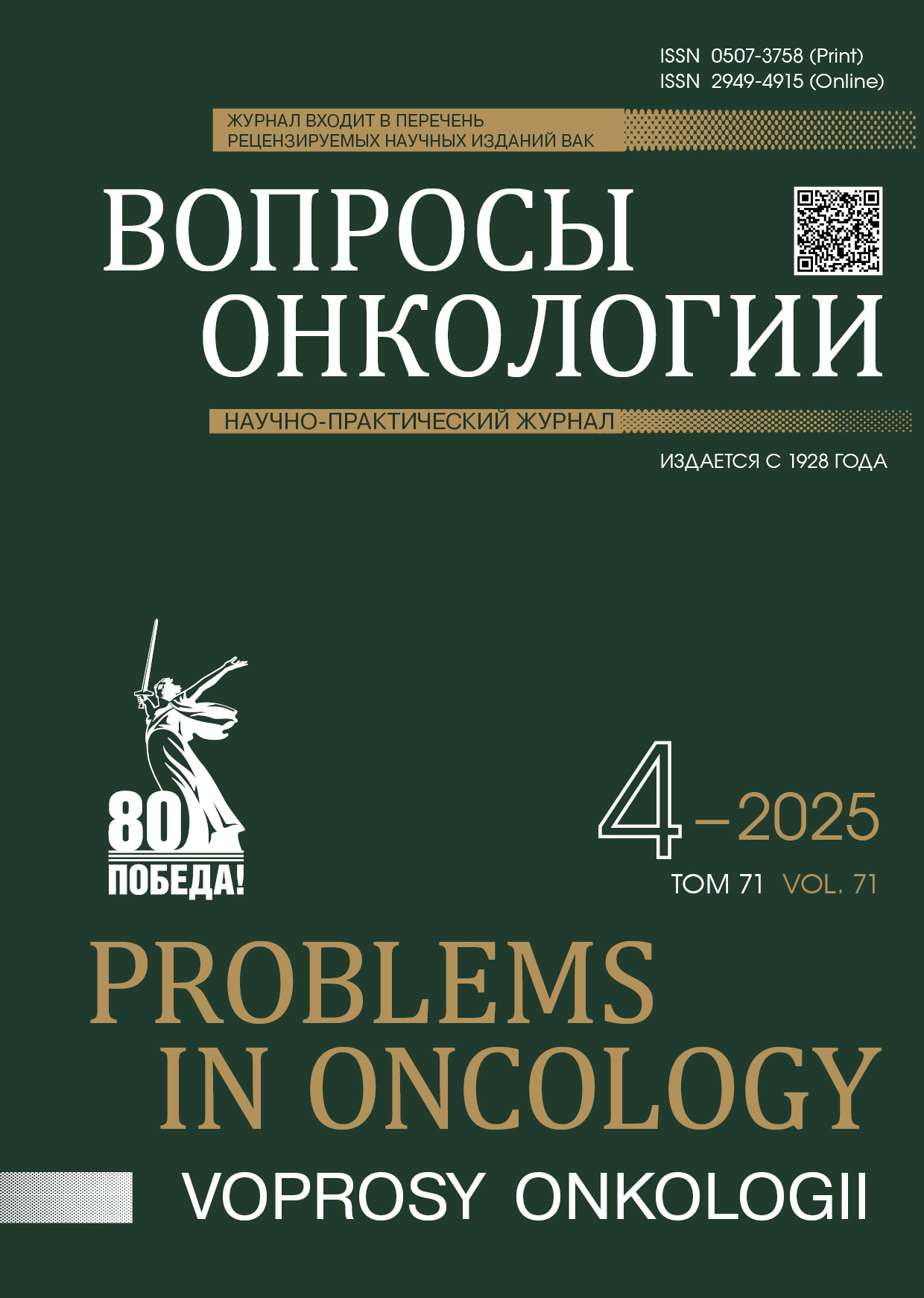Abstract
Introduction. Cutaneous melanoma currently lacks well-established molecular biomarkers for predicting immunotherapy response. Emerging candidates under investigation include interferon-stimulated gene (ISG) signatures and cancer-testis antigen (CTA) expression profiles.
Aim. The study performed to characterize the interplay between ISG signatures and CTA expression patterns in cutaneous melanoma patients.
Materials and Methods. The study utilized normalized whole-genome sequencing data comprising expression levels of 43,000 genes from 457 cutaneous melanoma patients, sourced from the publicly available University of California Santa Cruz (UCSC) dataset. Our analysis focused on rhabdoid-testicular CTA genes (n = 186) and interferon-dependent ISG genes (n = 66), the latter analyzed as both full and brief signatures. We performed agglomerative hierarchical clustering via Ward's method separately for ISG and CTA groups. Statistical evaluation of cluster interactions employed seven complementary measures: Pearson's chi-square test, lambda coefficient, contingency coefficient, phi coefficient, Goodman and Kruskal's tau, uncertainty coefficient, and column proportion analysis.
Results. Analysis revealed four conserved ISG clusters across both datasets (two demonstrating high gene expression and two with low expression) showing strong correlation (λ = 0.666, p < 0.0001). For CTA genes, hierarchical clustering identified six primary clusters (two each of high, medium, and low expression genes) at the first level, which further differentiated into ten subclusters at the third clustering level. Initial comparison of first-level ISG and CTA clusters showed no significant association (p > 0.1). Evaluation of third-level CTA clusters against the brief ISG signature demonstrated a weak relationship (symmetric uncertainty coefficient = 0.031, p = 0.003). Only two third-level CTA clusters exhibited meaningful associations with ISG patterns: one characterized by minimal CTA expression coupled with high ISG activity, and another showing the inverse relationship of elevated CTA expression paired with low ISG signature.
Conclusion. This study confirms our prior findings regarding the heterogeneous expression profile of CTA in cutaneous melanoma. The majority of CTA clusters demonstrated no significant association with ISG signatures. The identification of specific CTA-ISG expression patterns as predictive biomarkers for immunotherapy response in melanoma patients warrants deeper investigation.
References
CTdatabase. Online database. Ludwig Institute for Cancer Research, Laboratorio National de Compulacao Cientifica. 2024.-URL: http://www.cta.lncc.br/ (01.06.2024).
Rozeman E.A., Hoefsmit E.P., Reijers I.L.M., et al. Survival and biomarker analyses from the OpACIN-neo and OpACIN neoadjuvant immunotherapy trials in stage III melanoma. Nat Med. 2021; 27(2): 256-263.-DOI: 10.1038/s41591-020-01211-7.-URL: https://www.ncbi.nlm.nih.gov/pubmed/33558721, https://www.nature.com/articles/s41591-020-01211-7.
Reijers I.L.M., Rao D., Versluis J.M., et al. IFN-γ signature enables selection of neoadjuvant treatment in patients with stage III melanoma. The Journal of experimental medicine. 2023; 220(5).-DOI: 10.1084/jem.20221952.-URL: https://rupress.org/jem/article-pdf/220/5/e20221952/1449193/jem_20221952.pdf.
Barrat F.J., Crow M.K., Ivashkiv L.B. Interferon target-gene expression and epigenomic signatures in health and disease. Nature immunology. 2019; 20(12): 1574-1583.-DOI: 10.1038/s41590-019-0466-2.-URL: https://pmc.ncbi.nlm.nih.gov/articles/PMC7024546/pdf/nihms-1556675.pdf.
Elnaggar M., Chaisuparat R., Ghita I., et al. Immuno-oncologic signature of malignant transformation in oral squamous cell carcinoma. Oral Surg Oral Med Oral Pathol Oral Radiol. 2023; 136(5): 612-622.-DOI: 10.1016/j.oooo.2023.07.009.
Bergamaschi C., Terpos E., Rosati M., et al. Systemic IL-15, IFN-γ, and IP-10/CXCL10 signature associated with effective immune response to SARS-CoV-2 in BNT162b2 mRNA vaccine recipients. Cell Rep. 2021; 36(6): 109504.-DOI: 10.1016/j.celrep.2021.109504.-URL: https://pmc.ncbi.nlm.nih.gov/articles/PMC8299183/pdf/main.pdf.
Орехов А.В. Марковский момент остановки агломеративного процесса кластеризации в евклидовом пространстве. Вестник Санкт-Петербургского университета. Прикладная математика. Информатика. Процессы управления. 2019; 15(1): 76-92.-DOI: https://doi.org/10.21638/11702/ spbu10.2019.106.-URL: http://hdl.handle.net/11701/15652. [Orekhov A.V. Markov moment for the agglomerative method of clustering in Euclidean space. Petersburg University Applied Mathematics Computer Science Control Processes. 2019; 15(1):76-92.-DOI: 10.21638/11702/ spbu10.2019.106.-URL: http://hdl.handle.net/11701/15652 (in Rus)].
Hartigan J.A. Clustering Algorithms. New York, London, Sydney, Toronto: John Wiley & Sons Inc. Press. 1975; 351.-URL: https://books.google.ru/books?id = cDnvAAAAMAAJ.-ISBN: 9780471356455.
Everitt B.S., Landau S., Leese M., Stahl D. Cluster Analysis. Chichester, West Sussex, UK: John Wiley & Sons Ltd. Press. 2011; 330.-URL: https://books.google.ru/books?id = w3bE1kqd-48C.-ISBN: 9780470978443.
Murtagh F., Legendre P. Ward’s Hierarchical Agglomerative Clustering Method: Which Algorithms Implement Ward’s Criterion? Journal of Classification. 2014; 31(3): 274–295.-DOI: 10.1007/s00357-014-9161-z.-URL: http://dx.doi.org/10.1007/s00357-014-9161-z.
Orekhov A.V. Quasi-Deterministic Processes with Monotonic Trajectories and Unsupervised Machine Learning. Mathematics. 2021; 9(18): 2301.-URL: https://www.mdpi.com/2227-7390/9/18/2301.
Binnewies M., Roberts E.W., Kersten K., et al. Understanding the tumor immune microenvironment (TIME) for effective therapy. Nature medicine. 2018; 24(5): 541-550.-DOI: 10.1038/s41591-018-0014-x.-URL: https://www.ncbi.nlm.nih.gov/pubmed/29686425.
Wu B., Zhang B., Li B., et al. Cold and hot tumors: from molecular mechanisms to targeted therapy. Signal transduction and targeted therapy. 2024; 9(1): 274.-DOI: 10.1038/s41392-024-01979-x.-URL: https://www.ncbi.nlm.nih.gov/pubmed/39420203.
Bulgarelli J., Tazzari M., Granato A.M., et al. Dendritic Cell Vaccination in Metastatic Melanoma Turns "Non-T Cell Inflamed" Into "T-Cell Inflamed" Tumors. Frontiers in immunology. 2019; 10: 2353.-DOI: 10.3389/fimmu.2019.02353.
Maleki Vareki S. High and low mutational burden tumors versus immunologically hot and cold tumors and response to immune checkpoint inhibitors. Journal for immunotherapy of cancer. 2018; 6(1): 157.-DOI: 10.1186/s40425-018-0479-7.-URL: https://www.ncbi.nlm.nih.gov/pubmed/30587233.
Naik A., Lattab B., Qasem H., Decock J. Cancer testis antigens: Emerging therapeutic targets leveraging genomic instability in cancer. Mol Ther Oncol. 2024; 32(1): 200768.-DOI: 10.1016/j.omton.2024.200768.-URL: https://www.ncbi.nlm.nih.gov/pubmed/38596293.
Gibbs Z.A., Whitehurst A.W. Emerging Contributions of Cancer / Testis Antigens to Neoplastic Behaviors. Trends in cancer. 2018; 4(10): 701-712.-DOI: 10.1016/j.trecan.2018.08.005.-URL: https://www.ncbi.nlm.nih.gov/pubmed/30292353.
Kurtenbach S., Sanchez M.I., Kuznetsoff J., et al. PRAME induces genomic instability in uveal melanoma. Oncogene. 2024; 43(8): 555-565.-DOI: 10.1038/s41388-023-02887-0.-URL: https://www.ncbi.nlm.nih.gov/pubmed/38030788.
Ayabe R.I., Seo Y.D., Melendez B., et al. Correlation of cancer testis antigen expression with high type-I interferon signal and prognosis in small bowel neuroendocrine tumors. Journal of Clinical Oncology. 2024; 42(3_suppl): 596-596.-DOI: 10.1200/JCO.2024.42.3_suppl.596.-URL: https://ascopubs.org/doi/abs/10.1200/JCO.2024.42.3_suppl.596.

This work is licensed under a Creative Commons Attribution-NonCommercial-NoDerivatives 4.0 International License.
© АННМО «Вопросы онкологии», Copyright (c) 2025

